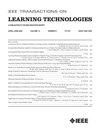A Dual-Mode Grade Prediction Architecture for Identifying At-Risk Students
IF 2.9
3区 教育学
Q2 COMPUTER SCIENCE, INTERDISCIPLINARY APPLICATIONS
引用次数: 0
Abstract
Predicting student performance in an academic institution is important for detecting at-risk students and to administer early intervention strategies. In this article, we develop a new architecture that achieves grade prediction based only on grades achieved over past semesters. Our proposed architecture involves two stages—weighted loss function incorporated to the long short-term memory (LSTM) model in the first stage, followed by a short-term gated LSTM in the second. The weighted loss function in the first stage ensures low prediction error by weighing loss associated with the minority class label (in our case the at-risk label). The short-term gated LSTM in the second stage, on the other hand, models short-term variations in academic performance to suppress any residual false alarms. Experiment results using three datasets obtained from over 20 000 students across 17 undergraduate courses show that the proposed model achieves a 28.8% improvement in F1 score compared to the LSTM model for at-risk detection. Students identified as at-risk have also been presented and validated by counselors via a dashboard.用于识别问题学生的双模式成绩预测架构
预测学术机构中学生的成绩对于发现问题学生和实施早期干预策略非常重要。在本文中,我们开发了一种新的架构,它可以仅根据过去几个学期的成绩来实现成绩预测。我们提出的架构包括两个阶段--第一阶段是将加权损失函数纳入长短期记忆(LSTM)模型,第二阶段是短期门控 LSTM。第一阶段的加权损失函数通过权衡与少数类别标签(在我们的例子中为高危标签)相关的损失,确保低预测误差。另一方面,第二阶段的短期门控 LSTM 对学习成绩的短期变化进行建模,以抑制任何残余误报。使用从 17 门本科课程的 20,000 多名学生中获取的三个数据集进行的实验结果表明,与 LSTM 模型相比,所提出的模型在风险检测方面的 F1 分数提高了 28.8%。辅导员还通过仪表板对被识别为高危学生的学生进行了展示和验证。
本文章由计算机程序翻译,如有差异,请以英文原文为准。
求助全文
约1分钟内获得全文
求助全文
来源期刊

IEEE Transactions on Learning Technologies
COMPUTER SCIENCE, INTERDISCIPLINARY APPLICATIONS-
CiteScore
7.50
自引率
5.40%
发文量
82
审稿时长
>12 weeks
期刊介绍:
The IEEE Transactions on Learning Technologies covers all advances in learning technologies and their applications, including but not limited to the following topics: innovative online learning systems; intelligent tutors; educational games; simulation systems for education and training; collaborative learning tools; learning with mobile devices; wearable devices and interfaces for learning; personalized and adaptive learning systems; tools for formative and summative assessment; tools for learning analytics and educational data mining; ontologies for learning systems; standards and web services that support learning; authoring tools for learning materials; computer support for peer tutoring; learning via computer-mediated inquiry, field, and lab work; social learning techniques; social networks and infrastructures for learning and knowledge sharing; and creation and management of learning objects.
 求助内容:
求助内容: 应助结果提醒方式:
应助结果提醒方式:


